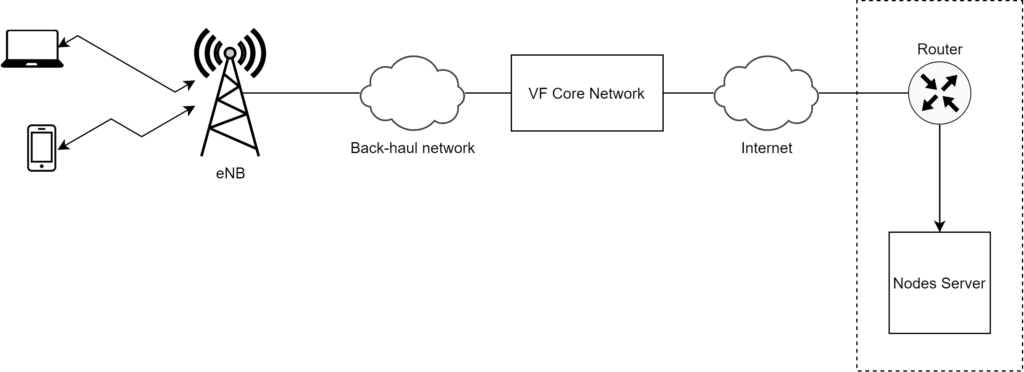For this project, a long-term evolution (LTE) communications testbed was used to study and analyse the streaming of videos using MPEG-DASH (Moving Picture Experts Group Dynamic Adaptive Steaming over HTTP) standard. This is an adaptive bitrate streaming technique used by many streaming platforms such as Netflix and YouTube.
The LTE testbed was implemented and configured through the support of Vodafone personnel. The router provided by Vodafone was used to connect a device (in this case a laptop) to the Web through the 4G network. The router itself contains a SIM card to allow access to the network, whilst another SIM card is used to record the received signal strength using a cellular device through the G-NetTrack Lite application. The accompanying diagram illustrates the path of the connections.
This study focuses on the use and benefits of using MPEG-DASH as an adaptive video streaming technique. Hence, any impairments on the audio aspect have not been considered. The different open-access videos used in the project were chosen from those made available by the Institute of Information Technology (ITEC), and were encoded using FFmpeg. FFmpeg is a very convenient open-source tool offering many useful libraries, including libx264 and additional subcommands that specify how the video is to be encoded.
The videos used were from three main categories, namely:
- Sports ‒ for fast-changing pixels in frames;
- Film/interview ‒ for a slower-paced but instant frame change;
- Animation ‒ to analyse a more artificial picture.
Performance curves were plotted to provide a visual assessment of the optimal parameters and limitations of the LTE system being tested. These performance graphs are the result of video frames versus important parameters, such as peak signal-to-noise ratio (PSNR), structural similarity index metric (SSIM) and derivations from the two. Using the open-source video-quality measurement tool (VQMT) executable through command prompt, Excel sheets were created with the parameter levels with every frame of the video, where the original video was compared against the recorded video. This provided a helpful representation of the quality of the transmitted video.

The objective metrics provided by VQMT are the following:
- PSNR: peak signal-to-noise ratio
- SSIM: structural similarity index metric
- VIFp: Visual Information Fidelity, pixel domain version
VQMT was used on the videos within the following parameters:
- Perfect conditions: optimal internet speed with a free, unoccupied bandwidth and sound-to-noise ratio (SNR) of 30dB or higher (excellent channel conditions). PSNR range 40-60dB.
- Bad-mid traffic with good channel conditions: internet speed ranging from 1Mbps to 20Mbps and SNR of 30dB or higher. PSNR range 10-30dB.
- Good traffic with bad-mid channel conditions: internet speed of 30Mbps and higher, with an average speed of 50Mbps and SNR in the range of 0dB to 20dB. PSNR range 20-45dB.
- Bad traffic with bad channel conditions (worst conditions): a combination of the bad conditions from Points 2 and 3 in this list. PSNR range: 5-15dB.
For each condition, a range of values using VQMT were obtained. Perfect conditions resulted in PSNRs in the range 40-60dB, whereas the worst conditions only managed 5-15dB. Bad-mid traffic conditions with good channel conditions performed worse than when there is good traffic coupled with bad-mid channel conditions with PSNR values in the range 10-30dB and 10-45dB, respectively. SSIM gave quite similar results in all cases, as envisaged. SSIM should not be below 0.8, and if this occurs it is most likely that the two videos are no longer in phase. Therefore, in such cases the reference frames were compared to wrong output frames.
References/Bibliography:
[1] S. Lederer, “Why YouTube & Netflix use MPEG-DASH in HTML5”, Bitmovin, 2015. [Online]. Available: https://bitmovin.com/status- mpeg-dash-today-youtube-netflix-use-html5-beyond/. [Accessed: 18- Aug- 2020].
[2] S. Lederer, C. Müller and C. Timmerer, “Datasets | ITEC – Dynamic Adaptive Streaming over HTTP”, Dash.itec.aau.at. [Online]. Available: https://dash.itec.aau.at/dash-dataset/. [Accessed: 17- Aug- 2020].
Student: Max Bonavia
Course: B.Sc. IT (Hons.) Computer Engineering
Supervisor: Prof. Ing. Carl James Debono
